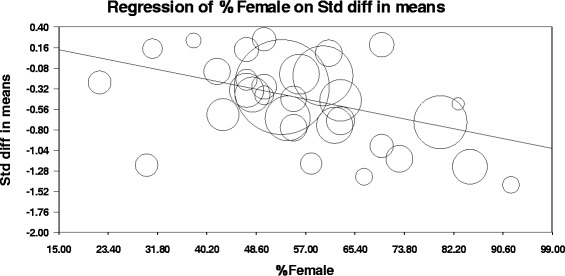Figure 3.

Univariate random-effects meta-regression of % female patients (predictor) on the weighted effect sizes d (outcome) in N = 32 HFL rTMS studies. Notes: The figure shows a scatterplot of weighted d/study (Y-axis) versus proportion of female patients/study (X-axis). The circles depict individual studies (the larger the diameter of the circle the larger the study weight). The slope of the regression line (B = −.01) was statistically significant (p two-tailed = .003) indicating that depression scores were significantly reduced after HFL rTMS compared to sham in studies with higher proportion of female patients. The predictor (% female patients) explained 97% of the between-study variance in weighted d according to the following formula: R 2 = 1-(T 2 model/T 2 total), where T 2 model (here = .00093) is the between-study variance in the weighted d unexplained by the regression model containing the predictor and T 2 total (here = .029) is the within- and between-study variance. The removal of the study with the largest weight (O’Reardon et al. 2007) did not change the outcome of this analysis (B = −.01, slope p two-tailed = .006; for a scatterplot see the Additional file 1). Abbreviations: HFL, high-frequency left rTMS; rTMS, repetitive transcranial magnetic stimulation; Std diff, standardised mean difference (Cohen’s d).
